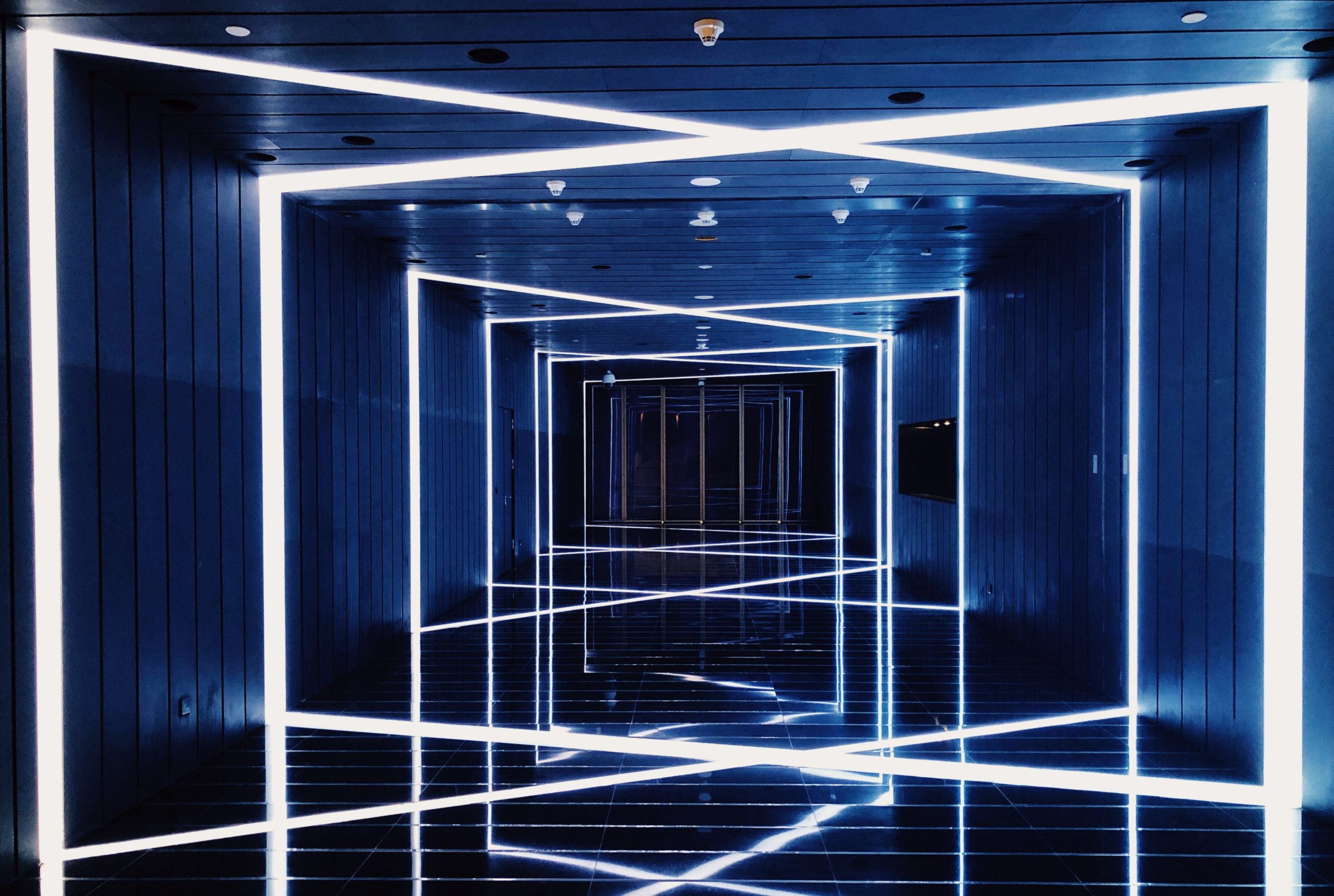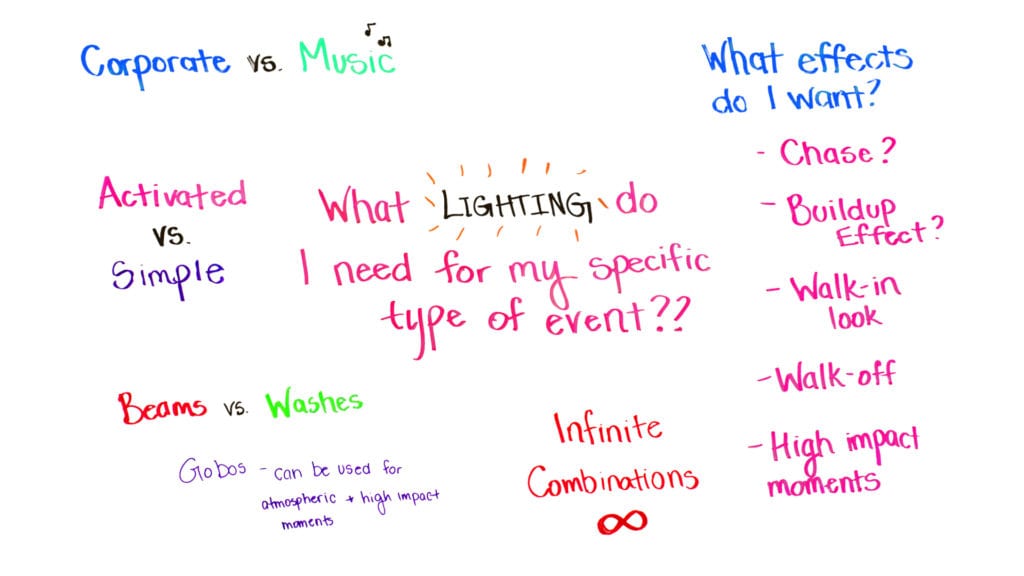Welcome to an exciting episode of Whiteboard Wednesday about event lighting 101! And let us just remind you, this is the first of the year. So we wanted to open 2020 with a relevant topic, and what’s better than lighting? Alongside all of the other endless aspects of an event, this is something planners need to worry about. Because it’s not as black and white as it might sound.
And in order to give you the best possible breakdown, we welcome our host, Shane. Shane is here today to spill all the important information about lighting in your event. It’s the ultimate crash course that will teach you the basics of what specifics you should be looking for a particular event. So, are you curious? Then press play, it’s time for event lighting 101!
Event Lighting 101: Breaking Down Everything You Need To Know – Video Transcription
Hi! Welcome to Whiteboard Wednesdays. I’m Shane, and today I’m going to be talking about my favorite aspect of event production: lighting. So when it comes to lighting packages, there’s a lot of complexity and most people don’t know what they need or what they might want. Let’s get into event lighting 101!
Event Lighting 101: Music & Corporate
So, first off, are we talking about a corporate event or music event, like a band or a show? A live performance? So, for music events and live performances, you probably want as many lights as you can afford. So if you can handle a bigger package, try to get an even bigger one. Request as many lights as you can get. Because then the lighting designer will have the most options and opportunities to create excitement and drama in the show. For a corporate event, though, you might not need the most advanced package that you could afford. You might be spending money on lights that you really don’t need. So it’s good to know what kind of looks you’re going to want. And then get a lighting package to suit both your budget and your actual event.
The Differences
So, for corporate events, the simple lighting versus activated lighting is kind of the first tier of how much you might be spending. So the very smallest budget shows can just have a simple lighting package that doesn’t actually get controlled during the show. Basically those lights are “set it and forget it.” The lighting designer will come in and set the lights up and they don’t even have to be there during the show.
Because they’ll just do their thing. They’ll either be static or sound-activated mode, where sound-activated mode can kind of flash colors as things hit. And a little bit to the pulse of the music, but they’re not going to be any type of specific look at any time. Versus the much more higher end for lighting packages and everything ranging from small packages up to very, very large, expensive packages will be controlled by an L1, which would be the lighting programmer. They’ll actually be using a lighting controller or a console so that they can control the lights to give you a specific look at a specific time. And with music that can be to the beat, it can take into account the high moments and the low moments and the big impacts.
Whereas for a corporate show, they can do everything from different types of looks for different parts of the show. As well as stage washes and all sorts of dramatic elements to enhance the show.
Event Lighting 101: Let’s Talk Specifics
So now once we’ve decided that we’re going with activated lights. And we’re going to have a lighting designer and a lighting programmer and someone who’s actively going to be controlling the lights for the whole show. There is still a huge assortment and a wide array of different packages and lighting effects that you can get. So the simplest lights are LED PARs or commonly referred to as “uplights.” They don’t actually literally have to be uplighting the wall. But that’s what they’re commonly used for. They may be just white or they might have every color available. So even simple lights that can’t move, these are in comparison to moving headlights, these lights can still create movement effects when combined together.
So let’s say you have five or 10 or as many as you can afford uplights, they can chase across the wall. One activates followed by the next and the next and the next until you can get movement effects between the different fixtures. So these lights will allow you to create movement and drama and on a very low budget. Because they are far less expensive than the moving headlights.
Moving Headlights
And then, once we get into moving headlights, there’s a lot of different options. We can talk about beams, we can talk about washes, we can talk about fixtures that include gobos. So washes are probably the simplest of the moving headlights. They allow you to kind of spread and cast the light over a large area. So you would use washes to create a nice stage wash so you can see everyone on the stage, whether they’re performing or just speaking. But then you can bring those down and you can cast them into the crowd or onto the walls to get color splashes and just various colors throughout your scene.
Beams are some of the most powerful lights you can use. Think of them as like a giant laser. Beam lights can allow you to extend your reach as a lighting designer beyond just the stage. Your beams can go out into the crowd and out past the confines of where all of your lights are living. And you can get a huge, high impact effect from these beams.
Gobos are wonderful, too. Some moving headlights have a whole wheel full of gobos that they can cycle through to create various effects from raindrops to bars of light. Even beam-splitting effects where it just kind of casts out a whole array of beams from a single fixture. And these types of lights can be used both in a low-energy type of atmospheric effect… They can just create simple motion or movement on a wall or on the floor. Wherever it might be needed, just to add a little bit of excitement. Or they can be used for a very high impact effect and they can completely change the look of a scene and add a lot of drama.
Event Lighting 101: Combinations!
So that kind of leads us into the infinite combinations of lights. Combining beams and gobos and spots all allow you to create unique effects. Anything that can be done just has a price. That’s why you’ve got to really decide what kind of effects your show needs for a corporate show. So most corporate shows are definitely going to need a stage wash. So, at the very least, you need two to four washes so that you can light up the stage. If you don’t need a lot of other looks, they can be static lights. They don’t actually have to be moving heads, but the moving headlights will allow you to do a lot more like a buildup effect and a walk-in look.
Corporate Show Lighting Examples
So typically for a corporate show, you want when the people are coming in, between the time that the doors open and the time that the show starts, you want a look, a lighting look. It’s typically called the “walk-in effect,” which is where maybe your moving heads are just kind of moving around a little bit to add a little bit of color, a little bit of drama. And just a little bit of excitement to the room, whereas the static stage washes like LICOs and anything else that might be providing that general wash without a moving head won’t be able to do. So if you don’t need that, then you can just stick with traditional lights. But if you do want that, then you need some moving heads.
Event Lighting 101: Think About The People
And then, for any type of show where you’ve got multiple speakers, if you want to keep the excitement up in between people coming up and down off the stage, you probably are going to want a walk-in look and a walk-off look. So when someone is done speaking and they’re leaving the stage, the moving heads can activate again. They can create a little bit of atmosphere and a little bit of excitement just to keep the crowd entertained while the next person is coming up. And so then these moving lights can also be used for buildup and high impact moments.
So for things like award shows where nominees are announced and you’re trying to build excitement and you’re waiting for the drama of the winner to be announced and the ultimate high impact moment, that’s when you can really get the most value out of moving headlights for corporate shows.
It Also Works For Music Events
So all of these can definitely be used for music events as well. You get all of your big impact moments and your highs and your lows throughout using different lighting combinations. So when it comes to corporate events, definitely talk to your AV provider and figure out what is going to be needed and what is going to give you the most bang for your buck. Because even corporate shows and music shows are all like… Nobody says they’re going to listen to a show. They go see the show. The lights are a really big part of everything.
Conclusions
So I hope you’ve enjoyed this Whiteboard Wednesday and the lesson on event lighting 101. If you did, give us the thumbs up and go ahead and subscribe so that you can see more. And don’t forget to tune in next week for more exciting content!
Resources
Event Lighting Ideas: Four Ways To Use Lighting At Your Event
16 Creative Lamps And Chandeliers To Inspire Your Event Lighting
Event Signage Ideas: Neon Light, Digital Badges, 3D Video Mapping
What are the Most Common Types of Event Lighting – Whiteboard Wednesday











